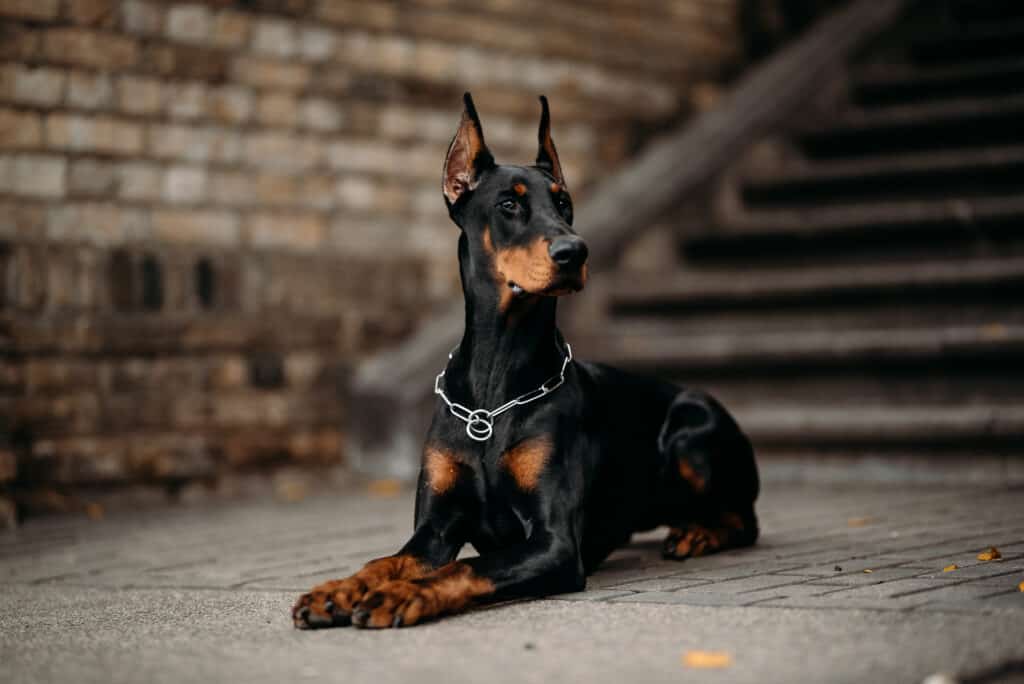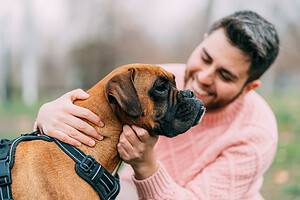When it comes to canine health, several dog breeds have more health issues than others. While any dog can develop an illness or disease based on their lifestyle, some purebred or designer breeds have a genetic predisposition to certain health issues.
Below, discover the 26 dog breeds with the most health issues, including brachycephalic dogs with ocular and respiratory issues, dog breeds with hip and joint health issues, and breeds that tend to develop more health issues as they age.
What Are the Dog Breeds With the Most Health Issues?
It’s difficult to determine with wide brush strokes the breeds with the most health issues, as every dog is unique. Lifestyle and owner care play massive roles in long-term health. However, as mentioned above, genetics also play a role in dog longevity, and some breeds have more predispositions for illnesses than others. Among the dog breeds with the highest predisposition for the most health issues are the following.
- English Bulldogs.
- Pugs.
- French Bulldogs.
- Cane Corsos.
- Shih Tzus.
- Boston Terriers.
- Shetland Sheepdogs.
- Miniature Pinschers.
- Miniature Schnauzers.
- Cavalier King Charles Spaniels.
- Yorkshire Terriers.
- Rough Collies.
- Boxers.
- Beagles.
- Golden Retrievers.
- Bernese Mountain dogs.
- German Shepherds.
- Rottweilers.
- Chesapeake Bay Retrievers.
- Newfoundlands.
- Saint Bernards.
- Great Danes.
- Mastiffs.
- Doberman Pinschers.
- Poodles.
- Basset Hounds.

The unique face and skull of a pug make it prone to eye bulging and respiratory issues.
©220 Selfmade studio/Shutterstock.com
Brachycephalic Dog Breeds and Their Health Issues
“Flat-faced” or brachycephalic dogs have a face structure that inhibits proper breathing. Their shortened faces and muzzles make it harder to get air in — some veterinarians even describe the condition as breathing through a straw for your entire life.
English Bulldog
The common health condition English bulldogs and other brachycephalic breeds suffer from is Brachycephalic Obstructive Airway Syndrome (BOAS). With BOAS, dogs may snore, wheeze, or snort and have labored or open-mouth breathing. This health issue has several anatomical causes, including:
- Stenotic nares.
- Elongated soft palate.
- Everted laryngeal saccules.
- Hypoplastic trachea.
With early detection, treatment may get a better outcome. BOAS can become an emergency without warning, so understand the warning signs of a respiratory crisis and know who to call or what to do to ensure your dog makes it to the vet on time.

An English bulldog’s unmitigated brachycephaly can shorten its lifespan.
©Vera Reva/Shutterstock.com
Pug
The pug breed also suffers from BOAS. Pugs specifically have an oddly-formed skull that makes their nostrils (also known as their soft palate) too small. This obstructs airflow for the dog, negatively affecting their ability to breathe unencumbered.
The shape of the pug’s skull isn’t the only thing that becomes a big risk factor for BOAS. According to a recent study from PLOS Genetics about brachycephalic dogs and their DNA, the gene ADAMTS3 may run alongside skull shape as a risk factor. Researchers found that dogs with two copies of the mutation had worse breathing than dogs with only one.
French Bulldog
Owners with a Frenchie suffering from BOAS have a few ways to protect their dog from developing a respiratory emergency. This includes:
- Weight.
- Temperature.
- Surgery.
Keeping a Frenchie at a healthy weight will help the dog’s respiratory system work as it’s supposed to. Overweight dogs need more oxygen to survive, and the increased weight puts strain on the dog’s entire body. Regulating your Frenchie’s temperature on hot or cold days will also let your dog’s body focus on working as it’s supposed to instead of struggling to keep up with a significant temperature change. Finally, if your Frenchie has consistent trouble breathing and your veterinarian suggests surgery, the option might provide a better quality of life for them.
Cane Corso
According to the American Kennel Club’s standards, cane corso dogs are brachycephalic and can inherit a host of breathing problems.
However, instead of suffering from BOAS, cane corsos will develop dyspnea, or difficulty breathing. This might manifest as gasping for breath, particularly after exercise. When cane corsos exhibit symptoms of dyspnea for more than five or 10 minutes, it’s time to call the vet. They may be in a respiratory crisis.
Thankfully, if or when your cane corso snores, they’re not experiencing a respiratory emergency. It’s common for the breed to snore.
Shih Tzu
Like bulldogs and pugs, shih tzus suffers from BOAS (other names include respiratory distress syndrome and brachycephalic syndrome). BOAS can cause “shoulder” issues, like excessive gas from all the extra air intake or pneumonia from aspirating pieces of food.
Boston Terrier
The last brachycephalic breed on the list, the Boston terrier, will experience many of the same symptoms as the other short-snouted breeds. Boston terriers specifically may struggle to exercise based on the lack of air they’re able to get into their lungs. As such, walks and strenuous activity in hot weather can spell disaster quickly. Because dogs regulate their temperature through panting (and a few other methods), BOAS will negatively impact how quickly this breed can cool itself down.
Dog Breeds With Senior Health Issues
Dogs will inevitably develop more health issues as they get older. Some dog breeds, however, have the predisposition to develop more medical issues, like arthritis or kidney disease, than others in their old age.
Shetland Sheepdogs
Did you know that according to Nationwide’s Pet Health Analytics, Shetland sheepdogs have the highest chance of developing kidney disease as a senior dog (11 to 12 years old)?
Kidneys filter blood. When these organs lose 75% of their functionality, the kidneys have technically failed.
To avoid getting kidney failure, owners of Shetland sheepdogs can feed their pups specific prescription diets that reduce the load of waste or toxins the kidneys need to filter out.
Miniature Pinscher
Despite diabetes’s reputation as a disease of aging dogs, some breeds have a higher proclivity to develop it in old age compared to others. Miniature pinschers and miniature schnauzers have nearly the same number of claim risks for pancreatitis in their senior years. Still, the miniature pinscher also tops the charts of the most diabetes claims in senior individuals of the breed. Diabetes in miniature pinschers (and all dogs) occurs in the insulin-deficient form and the insulin-resistant form.

The MinPin can develop both pancreatitis and diabetes as a senior.
©Cars and Travels/Shutterstock.com
Miniature Schnauzer
When it comes to senior miniature schnauzers, owners should stay aware of their pup’s weight and eating habits. Pancreatitis, which obesity, eating table scraps or trash, and elevated fat levels can cause, affects miniature schnauzers almost as much as miniature pinschers. Miniature schnauzers come in second place behind miniature pinschers for claim risks for both pancreatitis and diabetes.
Cavalier King Charles Spaniel
Cavalier King Charles spaniels have a clear risk for senior cardiac disease compared to other dogs. However, all toy and small-breed dogs have a higher risk of developing senior cardiac diseases like cardiomyopathies. Congestive heart failure remains the most common result of cardiac disease in cavalier King Charles spaniels (and most toy/small breeds).
Yorkshire Terrier
While Shelties have the highest claim risk for senior kidney disease among dog breeds, Yorkshire terriers follow close behind. Usually, this disease will start to affect Yorkies 10 years and older. Early detection can elongate a dog’s life — because once they go into renal failure, the illness is irreversible.
Rough Collie
Topping the list of dog breeds with the highest risk of developing senior arthritis are rough collies. Interestingly, smooth collies have less of a risk.
According to the research conducted by the Nationwide Pet Health Analytics and Insights Team, rough collies have a higher percentage risk of developing arthritis in their senior years than a whopping 81 other purebred dog breeds. The team also found that owners of purebred dogs were more likely to submit pet insurance claims for senior arthritis than mixed-breed dog owners.
Dog Breeds With the Highest Risk for Cancer
Did you know that nearly 50% of dogs over the age of 10 will develop cancer at some point in their remaining life? Based on research, the breeds below have a higher chance than other breeds of developing a certain type of cancer — though the exact reason why certain breeds develop cancer over others remains unknown.
Boxer
When adopting a boxer, owners should know that the number one health issue cited for the breed is cancer. The boxer breed has the predisposition to develop several certain cancers, including mast cell tumors, melanoma, lymphoma, and hemangiosarcoma. When it comes to mast cell tumors, research indicates that most purebred boxers will develop lower-grade tumors. Melanoma usually affects boxer dogs that are 10 years or older — as does hemangiosarcoma. According to the UK Kennel Club, just under 40% of boxers will develop cancer in their lifetimes.

Boxers have an increased risk of developing several types of cancer compared to other purebred breeds.
©Gabor Kormany/Shutterstock.com
Beagle
The happy-go-lucky beagle stands to develop three types of cancers: bladder cancer, lymphoma, and osteosarcoma. Signs of your beagle developing cancer depend on the type of cancer they have. Blood in urine or frequent urination may signal bladder cancer in a beagle. While loss of appetite and weight loss indicate a problem for both lymphoma and osteosarcoma, swelling of the face may specify lymphoma. Conversely, you may notice swelling in your dog’s ribs or lumps on your beagle’s body if they develop osteosarcoma.
Golden Retriever
Speaking of happy-go-lucky dog breeds — the friendly and affable golden retriever has a high risk of developing both lymphoma and hemangiosarcoma, as well as histiocytic sarcoma. Finally, golden retrievers may also develop mast cell tumors.
Bernese Mountain Dogs
Bernese mountain dogs are generally healthy outside of their predisposition to cancer. Bernies may develop hemangiosarcoma, lymphoma, and mast cell tumors. Owners should keep an eye on their Bernie and make all vet appointments since hemangiosarcoma can lie in wait until it’s too advanced to fix. If your Bernese mountain dog has pale gums or consistently exhibits signs of fatigue and weakness, ask your vet for a blood test.
Dog Breeds With the Most Hip and Joint Health Issues
Four-legged friends who love to stay active (and therefore overwork their muscles) throughout their lives may develop hip and joint issues. Overweight or obese dog breeds can develop these issues, too. Overall, joint and hip health issues like hip dysplasia usually affect larger-breed dogs.
German Shepherd
The German Shepherd breed has a predisposition to hip problems, which affect up to 20% of all dogs in the breed. The most common hip problem is hip dysplasia, a loosening of the hip joint that causes discomfort and pain when walking or exercising. Hip dysplasia will also cause dysfunction, and affected German shepherds may develop an odd gait to compensate for the pain. Based on the most recent research, developing hip dysplasia is hereditary.
Rottweiler
Like German shepherds, Rottweilers count themselves as one of the purebred breeds most affected by hip dysplasia. Because the head of their femur won’t fit into their hip socket, Rottweilers with hip dysplasia can lose mobility in part or completely. Providing joint supplements, hip and joint-specific food, and keeping your Rottweiler at a healthy weight support a hip dysplasia-free lifestyle.
Chesapeake Bay Retriever
Not only are Chesapeake Bay retrievers prone to hip dysplasia, but they may also develop a neurodegenerative disease that affects mobility and legs called degenerative myelopathy. If your Chesapeake Bay retriever has degenerative myelopathy, they’ll lose function in their back legs within the first year of their life. The paralysis can spread to the front legs, though this usually occurs between the sixth and eighth year of their lives.
Newfoundland
Outside of hip dysplasia, Newfoundlands (or Newfies) may develop elbow dysplasia, arthritis, a luxating patella, osteochondritis dissecans, and meniscus tears. Because Newfies tend not to let their emotions show through their stoic exterior, owners should keep a close eye on their movements to decipher if they’re moving normally or not.

The weight of a Newfie can stress their hips and joints.
©Roman Zaiets/Shutterstock.com
Saint Bernard
Mobility loss in Saint Bernards comes down to three hip and joint diseases:
- Hip dysplasia.
- Elbow dysplasia.
- Osteoarthritis.
While we’ve discussed hip and elbow dysplasia at length above, osteoarthritis poses a significant risk to the breed. Behind German shepherds, Rottweilers, and Labrador retrievers, Saint Bernards run a high risk of developing osteoarthritis. As adult male Saint Bernards can weigh as heavy as 180 pounds, the massive weight on their joints and skeleton places additional strain (than a much smaller dog would place on their joints), which invites the potential for arthritis to develop. Saint Bernards with osteoarthritis or hip and elbow dysplasia may struggle to climb stairs, jump onto the couch, or walk normally.
Great Dane
Like other large breeds mentioned, Great Danes tend to have a higher risk for hip and joint issues. They remain one of the top breeds that develop hip dysplasia and joint disease.
Keeping your Great Dane at a healthy weight is one of the best preventative measures you can take to protect your dog’s hips and joints. According to Winter Park Veterinary Hospital, overweight Great Danes can develop arthritis over two years earlier than other breed individuals of a healthy weight — causing unnecessary discomfort for your dog.
Mastiff
The massive, lumbering mastiff falls in a similar category to many of the dogs mentioned already in this section. Thanks to their heavy body weight — up to 170 pounds for females and 230 for males — their joints begin to degenerate as they get older. In addition to maintaining a healthy weight for your mastiff, help them avoid roughhousing and excessive jumping to reduce the strain they put on their joints and legs.
Dog Breeds With the Most Organ Health Issues
Some dog breeds have a proclivity over others to develop health issues in specific organs, like the heart, the eyes, or the lungs.
Doberman Pinscher
Dr. Mollie Newton, a devoted animal lover, veterinarian, and the founder of PetMeTwice.com, indicated that genetics is often to blame for purebred dog breed health issues. When it comes to Doberman pinschers, genetics remains the culprit of nearly all the most common health issues.
“These health issues are frequently rooted in genetics. Dilated cardiomyopathy, characterized by heart weakening and enlargement, impairs blood circulation. Von Willebrand’s disease, an inherited bleeding disorder, results from a deficiency in von Willebrand’s factor, leading to excessive bleeding. Hip dysplasia, primarily linked to genetics, causes improper hip joint development, resulting in instability and arthritis. Hypothyroidism, also frequently hereditary, occurs due to an underactive thyroid influenced by genetic or autoimmune factors.”

Unfortunately, Doberman pinschers have a multitude of organ-related health problems.
©JELIZAVETA KARAKAJA/Shutterstock.com
Poodles
When it comes to seeing clearly, poodles count themselves as one of the breeds with an increased risk for glaucoma. They may develop either primary or secondary glaucoma.
As a disease, glaucoma develops from inadequate drainage of aqueous fluid. Poodles with glaucoma may exhibit water discharge from one or both eyes, indicate they have eye pain, develop a cloudy or bluish cornea, or have swelling around the eye. Significant signs of acute glaucoma include unresponsiveness and blindness — both of which can occur suddenly and out of the blue.
Basset Hounds
Among the many health issues, Basset hounds have a predisposition to develop bloat. While larger dogs like Great Danes, mastiffs, and Saint Bernards have the highest risk for bloat, Basset Hounds also have a deep, narrow chest that facilitates the development of bloat.
When bloat occurs, your dog’s stomach twists and fills with gas, getting so big that it cuts off its blood supply to itself. Bloat is an emergency — if you see signs of it, take your Basset hound to the vet immediately. Some cases become fatal in as few as 30 minutes.
Keeping Your At-Risk Dog Healthy
Every dog’s health journey is different. In most cases, the chance of developing a certain disease largely depends on lifestyle, nutrition, exercise, and risk factors. Owners can only control so many of the risk factors and do not influence genetics. As such, they can do their best to keep their furry friend healthy by learning more about their dog breed’s health risks, getting annual check-ups at the vet, contacting the vet when something seems off, and providing excellent nutrition for their pet’s needs.
The photo featured at the top of this post is © fongleon356/iStock via Getty Images
Ready to discover the top 10 cutest dog breeds in the entire world?
How about the fastest dogs, the largest dogs and those that are -- quite frankly -- just the kindest dogs on the planet? Each day, AZ Animals sends out lists just like this to our thousands of email subscribers. And the best part? It's FREE. Join today by entering your email below.
Thank you for reading! Have some feedback for us? Contact the AZ Animals editorial team.







